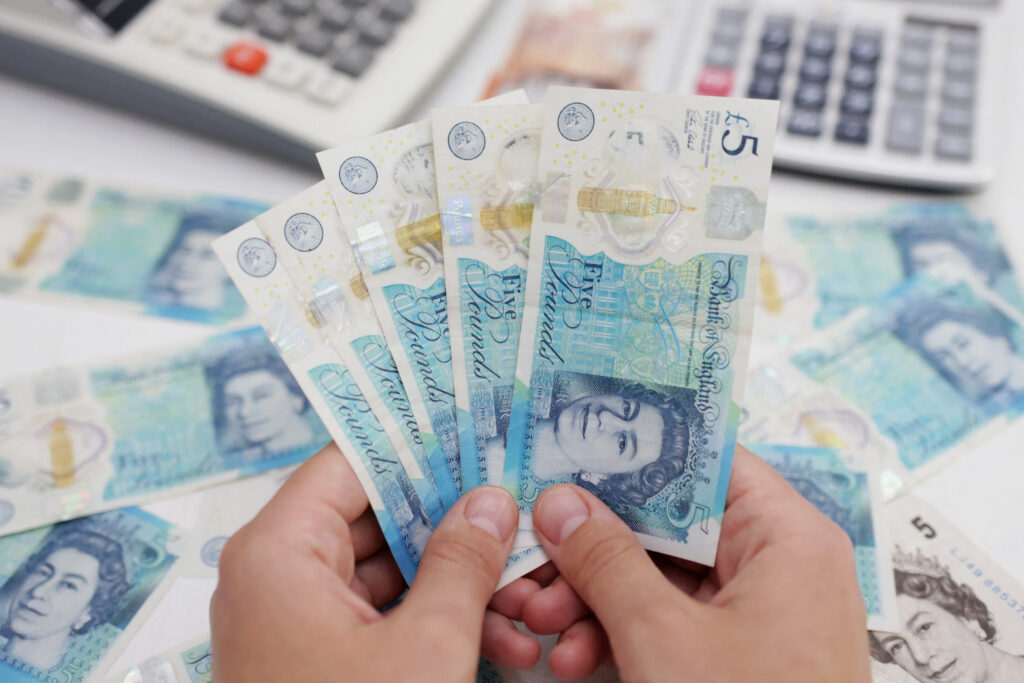(Reuters) – Speculators have amassed their biggest long position in sterling in dollar terms since Brexit, but untamed inflation and weak growth mean the party in the pound will not last, say hedge funds and their investors.
Net long speculative positions reached $4.7 billion as of July 11, the most valuable in dollars since mid-2014, two years ahead of the Brexit referendum, data from the Commodity Futures Trading Commission (CFTC) showed on Friday.
Just in terms of futures contracts, it is the biggest net long position since 2007.
UK inflation defied expectations in each of the past four months, which has sent the pound up 8% against the dollar this year, while U.S. inflation has fallen.
British wage growth broke above 7% in May for the first
time since the 1990s, driving the Bank of England to deliver a surprise half-point hike in June. Traders, who bet the BoE would be nearly done in May, are now pricing in rates rising above 6% from 5% right now.
This has kept $5.8 billion Rotterdam-based investment manager Transtrend for instance long sterling. It maintains a bullish position in its systematic computer trading, Diversified Trend Program (DTP) fund.
“We do have an active position in sterling within our Diversified Trend Program. We have been long GBP against a variety of other currencies since March,” said Marc van Loo, part of the investor relations team at Transtrend.
“This position is part of a ‘BoE yield rise’ trend cluster, which also includes shorts in British interest rate instruments, where we have a short position since April,” van Loo added.
As traders ratchet up their expectations for the Bank of England to raise rates, they’re also increasingly pricing in the chance that U.S. rates may be about to peak.
BEARISH MOMENTUM
The strength in the pound is equally a story about weakness in the dollar, said Robert Sears, chief investment officer of Capital Generation Partners, an investor in hedge funds and for family offices and endowments.
“Momentum on the dollar has turned bearish, so a lot of people are jumping on this trade. That is where the herd wants to be at this moment: short the dollar,” said Sears.
As a whole, hedge funds have been a lot more cautious in adding to their bullish positions on the pound.
CFTC data shows leveraged net participants – which broadly covers hedge funds – have cut their net long position in sterling by roughly a third since June’s nine-month high to around $2 billion.
Family office investor Michael Oliver Weinberg said deteriorating growth would be offset by sticky inflation, which limits the BoE’s actions and means rate cuts are less likely.
“This puts a floor on the pound,” he said.
Hedge funds that take a more active approach than computer-driven programmes that chase movements in currencies, say they are eyeing opportunities to short sterling.
The UK has a current-account deficit, which widened in the first quarter of 2023, as government income dropped and the trade deficit deepened. This leaves sterling vulnerable to sell-offs, BNP Paribas (OTC:BNPQY) said in a note on Monday.
John Floyd, chief investment officer of macro hedge fund Floyd Capital, said a slowdown in the housing market and rising mortgage rates could curb sterling’s rise.
“Aggressive BOE monetary tightening expectations, a gilt curve that has not been this inverted since 2000, and the fading of the new King’s coronation holiday lift may be other catalysts for a change in sterling’s trend,” said Floyd.
The other factor that Floyd said he was watching was China, where weak growth will bring down inflation and economic activity across Europe.



